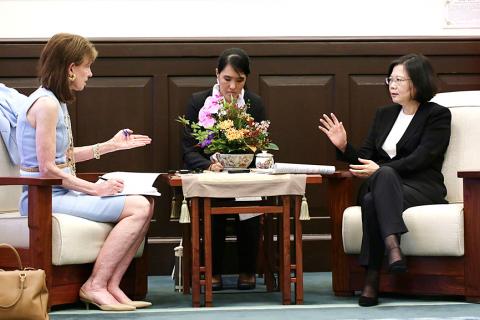President Tsai Ing-wen (蔡英文), for the first time since her inauguration, implicitly dismissed the so-called “1992 consensus” in an interview with the Washington Post, saying it is unlikely that her government would agree to a deadline for accepting conditions that go against the public’s will.
Tsai gave her first exclusive interview since taking office with Washington Post senior associate editor Lally Weymouth at the Presidential Office Building on Monday, with the president talking at length about cross-strait ties and the Taiwan-US relationship.
“I am certain that as a national leader, [Chinese President] Chairman Xi Jinping (習近平) is equipped with the ability to make a good and a right decision based on a comprehensive review of all the situations,” Tsai said when asked to verify reports that Xi has set a deadline for her to accept the “1992 consensus.”

Photo: CNA, courtesy of the Office of the President
Tsai said that given Taiwan has evolved into a mature democracy, where trends in public opinion matter greatly, it is unlikely that the government would accede to conditions set by the other side that are against the will of the people.
“I believe that they [Chinese authorities] are aware of this,” Tsai said.
The “1992 consensus,” a term former Mainland Affairs Council (MAC) chairman Su Chi (蘇起) admitted making up in 2000, refers to a tacit understanding between the Chinese Nationalist Party (KMT) and the Chinese government that both sides of the Strait acknowledge there is “one China,” with each side having its own interpretation of what “China” means.
Tsai has so far merely expressed respect for the “1992 talks.”
Praising Xi’s courage in tackling corruption as being conducive to the development of Chinese society, Tsai said she hoped that Xi could “show a bit more flexibility” in dealing with cross-strait relations and appreciate Taiwan’s democracy.
With regard to her plans for handling ties with Beijng amid a reported decrease in official cross-strait communications, Tsai said there are diverse channels of communication across the Taiwan Strait, including official links and person-to-person ties.
“There are differences between the positions held on either side of the Strait. In Taiwan, we have done our best to minimize that gap. I believe that the Chinese realize the goodwill we put forth at the inauguration,” Tsai said.
However, she declined to go into much detail when asked whether she is in touch with Chinese government officials, saying only that different levels of government have a variety of ways to communicate with their counterparts in Beijing.
Weymouth asked Tsai how she plans to strike a balance between maintaining cross-strait stability and responding to the expectations of her younger supporters, most of whom identify themselves as “Taiwanese” rather than “Chinese” and are perceived as champions of Taiwanese independence.
“It is a fact that different generations — and different people of different ethnic origins — have different views on China,” Tsai said. “However, they all agree on one thing: That is democracy.”
China’s Taiwan Affairs Office (TAO) spokesman Ma Xiaoguang (馬曉光) yesterday said that the maintenance of peaceful cross-strait development is supported by mainstream public opinion on both sides of the Taiwan Strait.
“Only by adhering to the 1992 consensus and its core meaning — that both sides belong to one China — can peaceful development of cross-strait ties be ensured,” Ma said.
Ma said that the communication mechanism between the TAO and the MAC, as well as between the semi-official Straits Exchange Foundation and its Chinese counterpart, the Association for Relations Across the Taiwan Straits, are both built on the “1992 consensus.”

The Central Weather Administration (CWA) yesterday said it expected to issue a sea warning for Typhoon Fung-Wong tomorrow, which it said would possibly make landfall near central Taiwan. As of 2am yesterday, Fung-Wong was about 1,760km southeast of Oluanpi (鵝鑾鼻), Taiwan’s southernmost point, moving west-northwest at 26kph. It is forecast to reach Luzon in the northern Philippines by tomorrow, the CWA said. After entering the South China Sea, Typhoon Fung-Wong is likely to turn northward toward Taiwan, CWA forecaster Chang Chun-yao (張峻堯) said, adding that it would likely make landfall near central Taiwan. The CWA expects to issue a land

Taiwan’s exports soared to an all-time high of US$61.8 billion last month, surging 49.7 percent from a year earlier, as the global frenzy for artificial intelligence (AI) applications and new consumer electronics powered shipments of high-tech goods, the Ministry of Finance said yesterday. It was the first time exports had exceeded the US$60 billion mark, fueled by the global boom in AI development that has significantly boosted Taiwanese companies across the international supply chain, Department of Statistics Director-General Beatrice Tsai (蔡美娜) told a media briefing. “There is a consensus among major AI players that the upcycle is still in its early stage,”

The Central Weather Administration (CWA) yesterday said it is expected to issue a sea warning for Typhoon Fung-wong this afternoon and a land warning tomorrow. As of 1pm, the storm was about 1,070km southeast of Oluanpi (鵝鑾鼻), Taiwan’s southernmost point, and was moving west-northwest at 28 to 32kph, according to CWA data. The storm had a radius of 250km, with maximum sustained winds of 173kph and gusts reaching 209kph, the CWA added. The storm is forecast to pass near Luzon in the Philippines before entering the South China Sea and potentially turning northward toward Taiwan, the CWA said. CWA forecaster Chang Chun-yao (張峻堯) said

Japanese Prime Minister Sanae Takaichi yesterday said that China using armed force against Taiwan could constitute a "survival-threatening situation" for Japan, allowing the country to mobilize the Japanese armed forces under its security laws. Takaichi made the remarks during a parliamentary session while responding to a question about whether a "Taiwan contingency" involving a Chinese naval blockade would qualify as a "survival-threatening situation" for Japan, according to a report by Japan’s Asahi Shimbun. "If warships are used and other armed actions are involved, I believe this could constitute a survival-threatening situation," Takaichi was quoted as saying in the report. Under Japan’s security legislation,